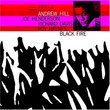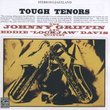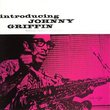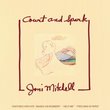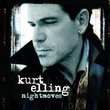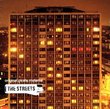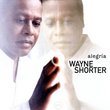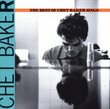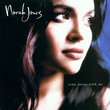| All Artists: Johnny Griffin Title: Blowin Session Members Wishing: 4 Total Copies: 0 Label: Blue Note Records Original Release Date: 1/1/1989 Re-Release Date: 5/18/1999 Album Type: Original recording reissued, Original recording remastered Genres: Jazz, Pop Style: Bebop Number of Discs: 1 SwapaCD Credits: 1 UPC: 724349900929 |
Search - Johnny Griffin :: Blowin Session
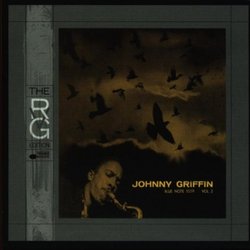 | Johnny Griffin Blowin Session Genres: Jazz, Pop
This freewheeling 1957 session features three of the finest tenor saxophonists of the hard-bop genre--Johnny Griffin, Hank Mobley, and John Coltrane. While tenor battles have been a feature of jazz since the '30s, the thre... more » |
Larger Image |
CD DetailsSynopsis
Amazon.com This freewheeling 1957 session features three of the finest tenor saxophonists of the hard-bop genre--Johnny Griffin, Hank Mobley, and John Coltrane. While tenor battles have been a feature of jazz since the '30s, the three here are so distinctive in their approaches that it's musicality that reigns and even the new listener will soon identify the three saxophonists' sounds. Griffin has been billed as the world's fastest saxophonist, a hard claim to verify, but few would argue with his aplomb as he tears off electrifying solos, negotiating quicksilver arpeggios with a gruff sound and the blues-tinged wail that he had mastered in Joe Morris's rhythm & blues band. Mobley's approach was more subdued, producing inventive streams of melody even in these heated circumstances, while Coltrane was already the most adventurous of the three, pressing the changes for new harmonic extensions. Bassist Paul Chambers and drummer Art Blakey are both supportive and forceful, while trumpeter Lee Morgan and pianist Wynton Kelly add some variety to the dominant tenor voices. --Stuart Broomer Similar CDs
Similarly Requested CDs
|
CD ReviewsOverrated, IMHO... BebopBoomer | Virginia | 03/14/2006 (3 out of 5 stars) "Though this CD gets 5 stars from most of your reviewers, and appears on a number of "best ever" lists, I'd like to offer an emphatic dissent.First the good things. The rhythm section is excellent,(even if Art Blakey is typically a bit overpowering), both generally and in its limited solo space. And Lee Morgan's playing is excellent. I've never heard him play less than well; he had it all--ideas,tone,technique,fire,taste.Mobley and Coltrane play well, though nothing here will startle or excite anyone familiar with their work around this time. As for the Johnny Griffin of the 50's:sure,he's one of the fastest horns in the West,but as a musician his talent ended at the wrists.Endless cockroach-on-the-keys scrambling up and down his horn,very little in the way of ideas,a harsh and at times plain out-of-tune upper register that sometimes sounded like somebody had stepped on a poodle. If you want to hear the difference between a real improvising musician and a cram-everything-in speed demon, compare the Monk-Sonny Rollins version of "Misterioso" with the Monk-Griffin version (each recorded right around this time). But JG is the dominant force/voice on this album,unfortunately. Sheer technical virtuosity has always played a role in jazz, but in the best jazz there's always a lot else besides. That's not the case here." Heated session, overly hot mic Samuel Chell | Kenosha,, WI United States | 12/11/2005 (3 out of 5 stars) "Few occasions can produce as much musical excitement as a gladiatoral meeting of tough tenors. An all too rare event these days, if you came of age in Chicago in the '60's and '70's you had bountiful opportunities both on the South Side (McKee's Show Lounge) and North (Joe Segal's Jazz Showcase) to hear the strongest and most personal voices on the instrument--Stitt, Jug, Dex, Moody, Jaws, Cohn, Sims, Turrentine, Ira, and Griff-- taking after each other in pairs, threes, and sometimes in fours. No recording can do justice to capturing such moments, but few, in my (apparently minority) opinion, fall as short as "Blowin' Session." Some of the blame lies with the programming. There's no shortage of Griffin to be heard, but the presence of Lee Morgan simply deprives both Mobley and Trane of comparable blowing time. But the real downer on this session is the quality of the audio. Who would have ever thought it possible to practically "homogenize" voices as distinctive as those of Griffin, Mobley, and Coltrane? The sonic canvas is depthless and dimensionless, the horns miked so closely that each is constantly on the verge of breaking up. Griffin's sound, in fact, is distorted throughout much of the program, a relentlessly grating roughness that makes it difficult to appreciate his normally crisp articulations and fluent melodic lines. Mobley and Coltrane, though artificially boosted in the sonic mix, come off better, thanks to Hank's less aggressive approach and to Trane's characteristically unforced use of the altissimo register. Overall, Coltrane's playing is surprisingly conservative on this session and his role quite limited. Of the three players, the real surprise, for some listeners, may be Mobley, who eschews charging ahead like a locomotive in favor of some thoughtful, "reactive" musical ideas. (Dig, especially, his masterfully constructed solo on the "Alternate Take" of ""Smoke Stack," which also features the best Coltrane on the date.) Unfortunately, Blakey's drums take their place in the foreground with the horns on Van Gelder's flat aural canvas, overshadowing both Paul Chambers' bass and Wynton Kelly's piano except for the solos. If you really want to compare the different and utterly unique sounds of Coltrane and Mobley, pick up "Someday My Prince Will Come," the Miles Davis session on Columbia that features both tenor players. If you want to hear the undistorted, "natural" sound of Johnny Griffin, go to his work on Riverside with Monk or on Jazzland with Lockjaw Davis or on Delmark with Ira Sullivan. If you're a musician and wish to hear and transcribe note for note (as I did several of the solos) some marvelous playing by Coltrane, Mobley, Al Cohn, and Zoot Sims, pick up "Tenor Conclave" on Prestige (it's still Van Gelder, but at Prestige Miles and the musicians were more in control of the sound than the engineer). Mobley opens the session on "Rhythm" changes and closes it (following Coltrane's solo!) with a knock-out solo and cadenza on "How Deep Is the Ocean." A recording with lots of notes, but all equally beautiful to those who have the ear for it. Unless I simply received a bad pressing (from BMG), "Blowin' Session," especially after all the hype that it's received, is one of the most overblown recordings I've ever come across." Great intro to Johnny Griffin! souldrummer | Washington, DC United States | 01/18/2004 (5 out of 5 stars) "This album is a great first choice for those looking to get into Johnny Griffin's work. The RVG sound is pristine. The band members enjoy each other's company. Griffin gets enough space to show his lightning fast chops in a casual setting that highlights his virtues against some of the top players Blue Note has to offer. The choice of material and the tempos indicate that Griffin is in charge of the proceedings; he's pretty much a pure tenor giant, not as much a composer or arranger of ensembles and standards are his thing. But in Mobley, Lee Morgan, and John Coltrane he has the type of bandmembers that challenge him to put his avalanche of ideas into a concise space. Griffin always plays for the crowd and you get his speed and it's always fun to see which tunes he's quoting in his solos. As an added plus, you get a rare sighting of Coltrane in the Blue Note Studios blowing some magesterial solos. [Sonny's Crib by Sonny Clark is another overlooked Trane as blue note side note session.] But everybody here can wail.I'd strongly recommend this album to young tenor saxophonists. They're playing standards that you'd typically see at jam sessions. Besides that, you get exposure to three of the giants of the instrument in one place. This is the type of album that can help those new to jazz learn how players have a particular style and approach to changes and a definitive tone. Trane's water dancing to Mobley's molasses to Griffin's avalanche gives you so much of the history of the saxophone with just a single performance.
This kind of session is what Griffin is all about; lightning fast playing on standards and positive hard bop stuff. I particularly enjoy "All the Things You Are" and "Just the Way You Look Tonight." Those who dig Griffin's playing would be wise to check out his live work with Monk "Thelonious in Action" and "Misterioso". I could go on and on about this album but I'll cut things off here. Just buy it!5 stars!" |

 Track Listings (5) - Disc #1
Track Listings (5) - Disc #1
